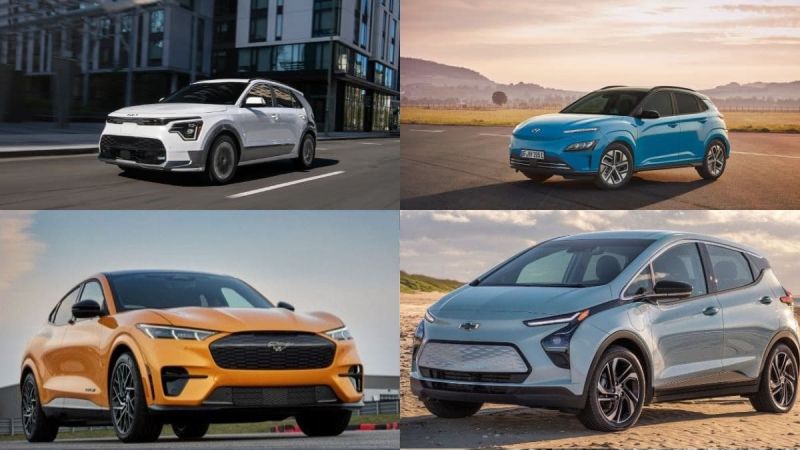But the average price is just that, an average, which means all new passenger vehicles for sale are included in the calculation. Of course that means there are some very expensive luxury or performance vehicles in there that skew the average (far more than there are basic, modestly priced new vehicles, unfortunately). But regardless, according to Cox Automotive and Kelley Blue Book, the average price of a new vehicle actually came down, slightly, in the most recent month data is available for (September), which I suppose is a good thing even though it was only a 1.8% decrease.
With the price of new vehicles so high, and the cost of fueling them high as well, many people are interested in purchasing vehicles that have lower operating costs. Since electric vehicles (EVs) pretty much have the lowest fueling costs, more and more people have been looking to buy one. But if you are a cost sensitive consumer looking for an EV, you may wonder, can I even find an EV that is at or under the average price of a new car? The answer is simply, yes.
Well, maybe it isn’t exactly simple, because the final price also may depend upon delivery, taxes, processing and other fees, any federal, state or local incentives, dealer mark ups, etc. So to be specific I am just talking about the Manufacturer’s Suggested Retail Price (MSRP). As such, there most certainly are a number of EVs that have a starting MSRP of $48,000 or less. Here’s the full list of 12 as of December 2022 (inclusive of 2023 models if their MSRP is available): Chevy Bolt and Bolt EUV ($25,600 and $27,200 respectively), Ford F-150 Lightning ($41,769, for the 2022 models only), Ford Mach-E ($46,895) Hyundai Kona ($33,550) and Hyundai Ioniq 5 ($41,450), Kia Niro EV ($39,450), Nissan LEAF ($27,800), Nissan Ariya ($43,190), Polestar 2 ($47,200, for the 2022 models only), Subaru Solterra ($44,995), Tesla Model 3 ($46,990), Toyota bZ4X ($42,000) Volkswagen ID.4 ($37,495). That makes a total of 14 EVs that are now selling at about the average price of a new car, or less. Is that a little surprising? Is it also surprising that there are at least 3 EVs that start under $30k and 3 more that start under $40k? Maybe, maybe not, but more importantly which of these EVs will save you the most money in fuel costs compared to gas powered options and what are the strongest selling points or features about each?
More or less in descending price order and using fueleconomy.gov to calculate costs per mile and with the average national price of a kWh at 16.6 cents and gasoline at $3.99 per gallon: the Polestar 2’s strongest selling points may be build quality and handling, and it consumes about 6.4 cents of electricity per mile, compared to about 13.3 cents per mile for a BMW 3 series. Note the Polestar 2 now has a $48,400 MSRP for the 2023 models. Next, the Tesla Model 3’s strongest selling point is probably its Supercharger network since no other network makes it as easy to cover long distances, something integral to many people’s commitment to switching to an EV. The Model 3 is more aerodynamically efficient than most other EVs and should cost around 4.2 cents per mile to drive compared to the same BMW 3 series above. The Ford Mach-E biggest selling point may be that it isn’t a Tesla. Ouch, what’s that supposed to mean? I am not making any specific digs at Tesla, I am only pointing out that not everyone wants one and Ford’s Mach-E was one of the first serious EV competitors to Tesla’s Model Y. The Mach-E costs the equivalent of about 5.5 cents per mile (assuming you don’t drive it too hard) and is about ⅓ the cost per mile of a regular Mustang, at 16.6 cents per mile.
The Subaru Solterra and the Toyota bZ4X are really the same car, made by Toyota, so they are interchangeable here and they don’t have many selling points yet because their wheels were falling off and apparently they may get especially terrible range in winter driving conditions too. Sorry Toyota (and Subaru), but you can do better. At least they should cost about 4.7 cents per mile to drive, compared to about 14 cents per gallon in a Subaru Crosstrek. The Hyundai Ioniq 5 and Kona are two of the lowest priced crossover EVs on the market plus the Ioniq 5 has 350 kW charging (basically the fastest charging speed you can currently get). Per mile costs for Ioniq 5 and Kona are about 5.2 (for the base Ioniq 5) and 4.7 cents per mile (for the Kona). The VW ID.4 is just at the upper end of the 5 lowest price EVs you can buy in the U.S. right now; price (and eligibility for the U.S. federal tax incentive) plus the ability to charge faster than all the other lowest price EVs may be its best marketing points. It costs about 5.1 cents per mile to drive. The 2023 Kia Niro EV can recharge faster than the cheaper Bolt EVs, the Kona and the LEAF, but not as fast as the ID.4 and is one of the more spacious compact EV crossovers. It costs 4.8 cents per mile to drive, compared to 12.9 cents per mile for a similarly sized Kia Soul gasoline powered crossover. The Nissan LEAF, in base form, only gets 149 miles of range on a full charge, but is easy to find and may not be marked up by dealers as frequently as other more in demand EVs can be. It costs about 5 cents per mile to drive. The new Nissan Ariya should be a very competitive all electric SUV with a lower price of entry than Kia’s EV6 and more versions/trims to choose from too. It should cost 5.5 cents per mile to drive, compared to the Nissan Rogue at 12 cents per mile. Finally, the two Chevy Bolts are the lowest priced EVs you can buy, have edgy styling, practical sizes and cost 4.6 (for the Bolt) - 4.8 (for the EUV) cents per mile to drive. Compare that to something like 14. 3 cents per mile in the Honda HR-V.
The Ford F-150 Lightning is the only EV pickup on this list, and I must point out that the ~$42k MSRP is for a version that may only be available to commercial buyers and is technically sold out (though there could be some remaining 2022 stock on some dealer lots somewhere out there). The prices seem to have gone up for 2023 models to almost $56k before the federal tax rebate is factored in. It might be fair to exclude this one from the list, but given it is still the lowest priced EV pickup you can buy today, I’ll still say that at 8.1 cents per mile, compared to 18.1 cents for the non-hybrid gasoline powered F-150, the Lightning could potentially save a lot of money on fuel costs if you can mostly charge it at home, on lower residential rates (or commercial rates if charging at work sites). Note, I also intentionally left off the Mazda MX-30 EV, which only costs $33,470, but is only for sale in California and has the lowest range of any new electric only vehicle on sale in the U.S. today (only 100 miles).
There you have it, at least a dozen or so EVs cost as much as or less than the average price of a new vehicle, proving that not all EVs are overpriced... at least not any more than their gasoline powered competitors. With the right calculus, and the ability to charge at home (or work) on most occasions, these EVs can save a lot of money on fuel costs. Please leave any questions or comments you may have below.
Images courtesy of Kia, Hyundai, Chevy and Ford.
Justin Hart has owned and driven electric vehicles for over 15 years, including a first generation Nissan LEAF, second generation Chevy Volt, Tesla Model 3, an electric bicycle and most recently a Kia Sorento PHEV. He is also an avid SUP rider, poet, photographer and wine lover. He enjoys taking long EV and PHEV road trips to beautiful and serene places with the people he loves. Follow Justin on Twitter for daily KIA EV news coverage.












